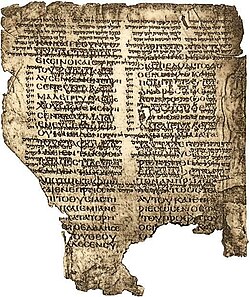Aquila's text is badly preserved. It has been written in two columns and 23 or 24 lines per page and contains parts of 1 Kings 20:7–17 [a] and 2 Kings 23:11–27 [b] (3 Kings xxi 7–17 and 4 Kings xxiii 11–27 according to Septuagint numbering). This palimpsest is written in koine Greek language, in bold uncial letters, without capital letters at beginnings or paragraphs or as the first letter of the pages. This is one of the few fragments that preserve part of the translation of Aquila, which has also been found in a few hexaplaric manuscripts.
Tetragrammaton and nomina sacra
The tetragrammaton is written in paleo-Hebrew script characters (  ) in following places: 1 Kings 20:13, 14; 2 Kings 23:12, 16, 21, 23, 25, 26, 27. [18] The rendering of the letters yod and waw are generally identical and the sign used for it is a corruption of both letters. In one instance, where there was insufficient space at the end of a line, the tetragrammaton is given by κυ, the nomen sacrum rendering of the genitive case of Κύριος which is unique in the Genizah manuscripts.
) in following places: 1 Kings 20:13, 14; 2 Kings 23:12, 16, 21, 23, 25, 26, 27. [18] The rendering of the letters yod and waw are generally identical and the sign used for it is a corruption of both letters. In one instance, where there was insufficient space at the end of a line, the tetragrammaton is given by κυ, the nomen sacrum rendering of the genitive case of Κύριος which is unique in the Genizah manuscripts.
AqBurkitt has used to argue for the reception history of Aquila's translation among Jews or to the use of nomina sacra by Jews. In an article focused on the topic, Edmon L. Gallagher concludes that there is no certainty about whether it was a Jew or a Christian who transcribed AqBurkitt, and thus it cannot be used as evidence in these debates.
